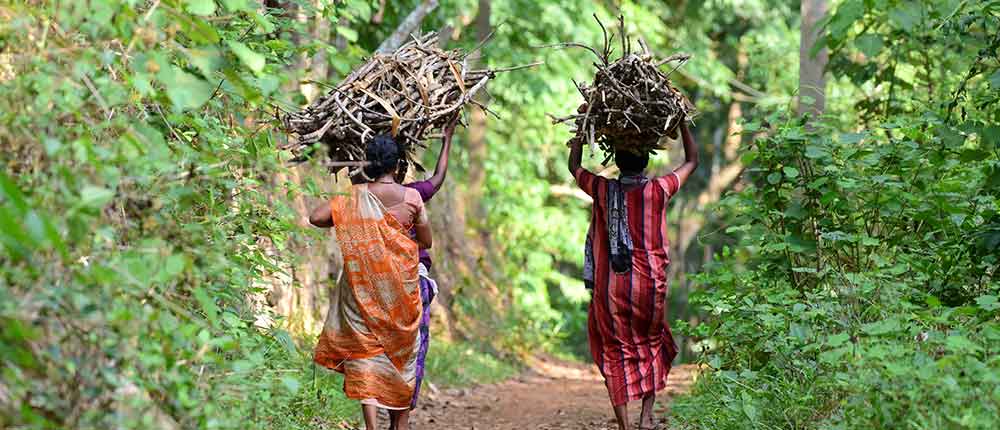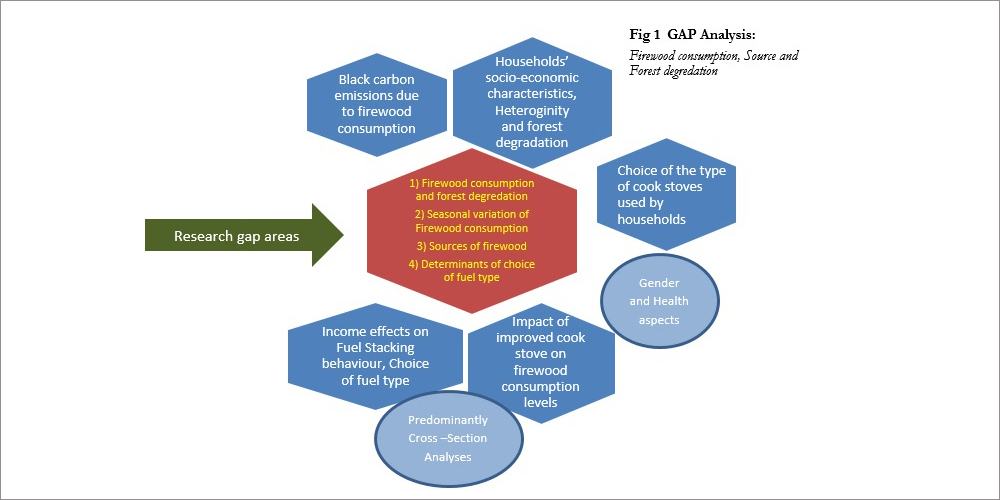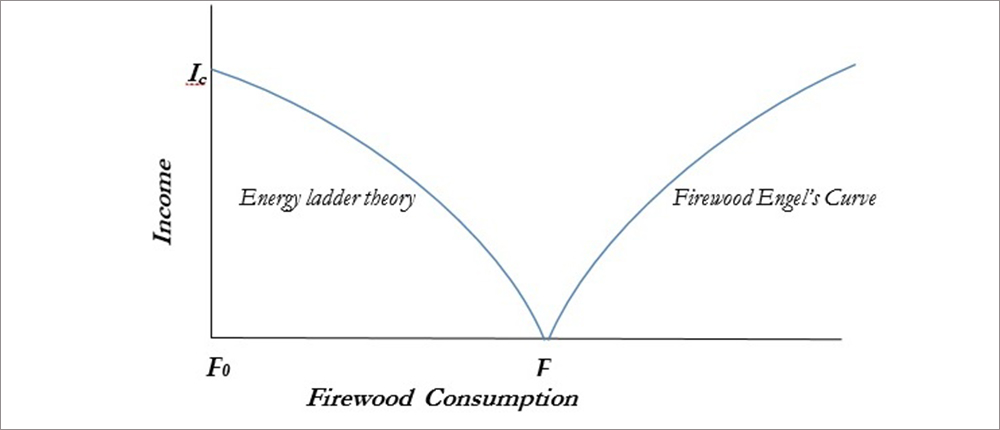The usage and dependence on firewood is more prominent in the Indian Himalayan region due to the additional requirements of room and water heating throughout the year

The Himalayan states of India, viz. Arunachal Pradesh, Assam, Himachal Pradesh, Jammu & Kashmir, Manipur, Meghalaya, Mizoram, Nagaland, Sikkim, Tripura, Uttarakhand and West Bengal are biodiversity hotspots, with a high percentage of their geographical area under forest cover. Many of them have a history of forest conservation and have seen many community-driven movements (Ishizaka, 2013).
The effects of firewood consumption in Indian Himalayan states for cooking and heating purposes have been studied widely. Affluent households with higher levels of firewood consumption are expected to collect or indirectly procure (via market) higher amounts of firewood from forests. Both demand for and supply of firewood is also expected to vary seasonally and thus determine their pattern of fuel stacking.
Table 1: Snapshot of Indian Himalayan States
| States | Share of geographical area in the Indian Himalayan Region | Share of rural households using firewood as fuel for cooking | Population density to All India density ratio | Share of area covered under forest to total land area | % Change in forest cover since 2013 |
| Arunachal Pradesh | 0.16 | 0.85 | 0.04 | 0.80 | -0.11% |
| Assam | 0.03 | 0.81 | 1.05 | 0.35 | -0.17% |
| Himachal Pradesh | 0.10 | 0.64 | 0.34 | 0.26 | 0.09% |
| Jammu & Kashmir* | 0.42 | 0.74 | 0.31 | 0.10 | 1.96% |
| Manipur | 0.04 | 0.82 | 0.30 | 0.76 | 0.02% |
| Meghalaya | 0.04 | 0.94 | 0.32 | 0.77 | -0.41% |
| Mizoram | 0.04 | 0.81 | 0.13 | 0.89 | -1.63% |
| Nagaland | 0.03 | 0.92 | 0.37 | 0.78 | -0.60% |
| Sikkim | 0.01 | 0.71 | 0.23 | 0.47 | -0.03% |
| Tripura | 0.02 | 0.93 | 0.94 | 2.51 | -0.21% |
| Uttarakhand | 0.10 | 0.63 | 0.49 | 0.45 | -1.11% |
| West Bengal | 0.01 | 0.39 | 2.78 | 5.71 | 0.14% |
Source: ENVIS Centre on Himalayan Ecology, Census 2011, Forest Survey of India (various years), Maps of India
*The data relates to 2017-18 when it was a single state of Jammu & Kashmir
The usage and dependence on firewood is more prominent among the hill states of India, specifically in the Indian Himalayan region, due to the additional requirements of room and water heating throughout the year.
Natarajan, I. (1995) looked at the trends in firewood consumption in rural Indian households and provided some initial results on the various sources of collection of firewood based on cross-section surveys of two points in time (1979 and 1993). The discussions around firewood consumption in the literature hitherto have often, directly or indirectly, linked it with forests and subsequently with black carbon. While firewood as a source for black carbon emissions has been widely studied and a large body of literature (Venkataraman, Habib, Eiguren-Fernandez, Miguel, Friedlander, 2005; Gustafsson, Kruså, Zencak, Sheesley, Granat, Engström, Praveen, Rao, Leck, Rodhe, 2009; Soneja, Tielsch, Curriero, Zaitchik, Khatry, Yan, Chillrud, Breysse, 2015; et al.) looks at the climate impact of black carbon emissions due to firewood consumption, almost none of these studies focus specifically on the firewood consumption pattern of households and its resultant effects on forest degradation over time.
Unclean fuels, environment, and health
Use of solid biomass in inefficient cookstoves causes millions of premature deaths and higher levels of environmental pollution (Balakrishnan et al., 2011; Chafe Zoë et al., 2014; Lacey et al., 2017) in rural areas, and especially in environmentally sensitive areas like the Himalayas. As per a recent policy brief by TERI, a very high percentage of Indian households were still reliant on solid biomass for cooking as recently as 2017 (Palit, D., M. Shardul and D. Brahmachari. 2021).
According to the Global Burden of Disease Studies (GBD), exposure to ambient and household fine-particulate matter or PM2.5 [Chowdhury et al. (2019)] estimate that the elimination of biomass for cooking would substantially improve the overall ambient air quality by 17.5%, which has the potential to reduce premature mortality by 6.6%.
With the slow rate of growth of LPG, the Government of India launched the Pradhan Mantri Ujjwala Yojana (PMUY) in May 2016 to facilitate underprivileged households' access to LPG for cooking (Cabinet Committee on Economic Affairs 2018). The scheme aimed to empower women and safeguard health. The PMUY was launched based on a study that was commissioned by the government in 2015, which revealed that high upfront costs and high refill costs were acting as the main barriers for the non-adoption of LPG over biomass (CRISIL 2011). The use of solid cooking fuel is associated with higher levels of environmental pollution and health burden (Balakrishnan et al., 2011; Chafe Zoë et al., 2014; Lacey et al., 2017).
The coverage has increased from 72% in 2014 to 96% till date; however, the refill rate remains low as it is still costly to afford even after pre-determined subsidy to a large rural population. To improve the clean energy access and affordability related concerns, the Government of India is providing free connections to Pradhan Mantri Ujjwala Yojana (PMUY) scheme consumers for cooking purposes and was subsidising LPG under Direct Benefit Transfer for LPG (DBTL) programme until recently.
However, as of September 2020, the same price (INR 594) will be applicable for subsidised and non-subsidised 14.2 kg cooking gas. This means that the subsidies that used to be transferred into the bank accounts of beneficiaries through the Direct Benefit Transfer Scheme (DBTL) have now been eliminated. (Economic Times, 2020) [1]
It is noteworthy here that the recent TERI policy brief clearly points out that the willingness to pay among poor households in India for a 14.2 kg LPG cylinder is INR 313/month in rural areas and INR 333/month in urban areas, as per the CRISIL report 2016 (Palit, D., M. Shardul and D. Brahmachari. 2021). As a result, the dependence on firewood as the main cooking fuel in rural India is expected to continue in near future due to its affordability, availability, and people's traditional habits and practice.
Existing literature and gaps
Some pioneering studies sponsored by the South Asian Network for Development and Environmental Economics (SANDEE) like Baland and Mookherjee (2013, 2014) explore overall consumption patterns of households over time. They also make some prudent observations through estimation of a firewood Engel's curve.
The authors identify household consumption levels and demographic reasons as significant factors for forest degradation in the Himalayan region. Specifically, they measure the effects of economic growth on forest degradation in terms of household consumption levels and conclude that demographic factors such as rise in population and increased fragmentation of rural households help explain forest degradation comparatively more significantly than economic growth. Further, they conclude that increased inequality or poverty levels do not seem to affect forest degradation.
However, the study does not focus on firewood consumption patterns and the sources from where the firewood is gathered or procured. Other studies like Adhikari, Bhim. (2002), Foster and Rosenzweig (2003), and Baland, Jean-Marie; Pranab Bardhan; et al (2003, 2010) etc. also explore the association between socio-economic characteristics of households and their dependency on forest resources, property rights, heterogeneity and demographic changes. While most of these papers look at the impact of the overall consumption pattern of households (as a proxy for income/economic prosperity) on forest degradation, almost none of them focus on a longitudinal observation of firewood consumption habits of households, the seasonal variation in their consumption pattern or the source from where the firewood is procured, along with its impact on forest degradation.
A large set of the existing literature focuses on improved cookstoves (Pattanayak & Pfaff, 2009; Subhrendu K. Pattanayak et al, 2015; Hanna, Duflo, and Greenstone, 2016), specifically the choice of the type of cookstoves used or preferred by households. Some studies like Adrianzen, M. A. (2013), Brooks, Bhojvaid, Jeuland, Lewis, Patange, Pattanayak (2016) look at firewood consumption from the perspective of cookstoves and evaluate the impact of improved cookstoves on firewood consumption pattern, as well as its linkages with health and gender aspects [Laxmi, Parikh, Karmakar and Dabrase, 2003, Duflo et al. (2016)]. Some others, such as Cheng and Urpelainen (2014) study the relation between household income and fuel stacking decision and behaviour. Swarup and Rao (2015) study the trends and patterns of household fuel choices in India. Some also look at determinants of fuel stacking behaviour and fuel choice (Deshmukh, Jinturkar and Anwar, 2014 et al.). However, almost all of them relate to the analysis of cross-section data. Figure 1 illustrates the research gaps found through this review of existing literature.

From the above discussion, it becomes evident that none of the above-mentioned studies explore the association between the seasonal variation in firewood consumption pattern of households, the source of firewood, and its association with forest degradation. Nor do they establish clear links between the choice of fuel type, the source of firewood procurement, and seasonal variation in firewood consumption. More so, the identified areas are found to be under-researched for the Indian Himalayan region, specifically for North East Indian states like Arunachal Pradesh where firewood consumption is one of the highest in the country and is expected to remain high due to traditional habits/ customs and lack of access to alternative fuel sources for cooking and heating.
Some theoretical context
The Energy Ladder Theory
The energy ladder theory suggests that households' income significantly influences factors related to fuel switching. Many studies too, confirm a positive relationship between income and fuel switching behaviour of households, usually onto cleaner, non-solid fuel sources (Van der Kroon, Brouwer and Beukering, 2013).
This implies households with higher income (or consumption expenditure) are expected to consume a lesser share of firewood. However, Baland and Mookherjee (2013) (based on their estimated household firewood Engel curves analysis) conclude that economic growth measured in terms of household consumption expenditure levels aggravates forest degradation in the mountainous region due to additional requirements for heating. Also, “that there is no evidence that poor households collect more firewood than non-poor households. In reality, it is the other way around.” This leads us to the question: whether rich households continue to use firewood in proportions that are larger compared to their poorer counterparts, even though they may use a higher fraction of cleaner fuel sources among the various types of fuel sources they stack. Further, if the source from where the rich households collect or procure firewood is via the market, that is, if it is the market-driven firewood supply that actually contributes to the forest degradation?
Firewood Engel curves and the Energy Ladder
The conflicting results based on the relationship between household income and level of firewood consumption as derived from studies that test the Energy Ladder theory (Van der Kroon, Brouwerand Beukering, 2013) and firewood Engel's curve estimations as presented in Baland and Mookherjee, (2013) motivate us to estimate a long run firewood Engel's curve using longitudinal data and test if the energy ladder theory remains valid.
To construct the long run firewood Engel's curve, one may follow the methodology as provided by Baland and Mookherjee, (2013) through which we can attempt to calculate the amount of firewood collected by the household compared to the district average and household income compared to the district average (in terms of standard deviations).
Various other papers too (Baland, 2003; Barrett, Mäler, Maskin, 2014; et. al) conclude that the firewood Engel curve is expected to show an essentially increasing relationship between firewood consumption and household income, while the Energy Ladder theory professes a reverse relationship between the two.

The figure above tries to plot a notional, graphical representation of these two differing ideas with the level of firewood consumption by households plotted along the horizontal axis and the levels of income of the households plotted along the vertical axis. Fo signifies the level of firewood consumption when income is equal to zero and Ic signifies a high level of income at which the households switch over to cleaner fuel sources, i.e. when their consumption of firewood becomes zero.
Based on the discussions so far, it becomes imperative that further studies need to be undertaken to understand better which of the above theories hold true for households' firewood consumption behaviour in the Indian Himalayan region, and more specifically, it becomes essential to search for the answer to the question derived from the survey of literature above: Whether it is the market-driven firewood supply (which we assume to be purchased by richer households more) that contributes to the forest degradation? A closer study of what explains the income effect on firewood consumption, and factors that explain the stacking behaviour and choices of households may help to answer it better.
References
[1] Economic Times, (September 2020) "Govt eliminates cooking gas subsidy as Covid turns oil market favourable" https://energy.economictimes.indiatimes.com/news/oil-and-gas/govt-eliminates-cooking-gas-subsidy-as-covid-turns-oil-market-favourable/77870487
Adrianzén, M.A. 2013. Improved cooking stoves and firewood consumption: Quasiexperimental evidence from the Northern Peruvian Andes. Ecological Economics, 89: 135-143
Andrew D. Foster, M. R. Rosenzweig. 2003. Economic Growth and the Rise of Forests. Quarterly Journal of Economics, 118 (2) 601-637. MIT Press
Balachandra, P. 2011. Dynamics of rural energy access in India: An assessment, Energy, 36(9), 5556-5567, ISSN 0360-5442, http://dx.doi.org/10.1016/j.energy.2011.07.017.
Baland J, Bardhan P, Das S, Mookherjee D and Sarkar R. 2007. `Managing the Environmental Consequences of Growth: Deforestation in the Himalayas', in Suman Bery, Barry Bosworth and Arvind Panagariya (eds.), India Policy Forum 2007, Sage Publications.
Baland J. & Libois F. & Mookherjee D. 2013. "Firewood collections and economic growth in rural Nepal 1995-2010: Evidence from a household panel," Working Papers 1215, University of Namur, Department of Economics.
Baland J.& Mookherjee D. 2014. "Deforestation in the Himalayas: Myths and Reality," 6143, SANDEE http://www.indiaenvironmentportal.org.in/files/file/Deforestation%20in%20the%20Himalayas.pdf
Bhim Adhikari. 2002. Property Rights And Natural Resource: Socio-Economic Heterogeneityand Distributional Implications Of Common Property Resource Management In Nepal, Discussion Paper, Advanced Workshop on Property Rights Structures and Environmental Resource Management Durban, South Africa. http://citeseerx.ist.psu.edu/viewdoc/download?doi=10.1.1.203.3976&rep=rep1&type=pdf
Brooksa N, Bhojvaid V, Jeuland MA, Lewis JJ ,Patange O,Pattanayak SK. 2016. How much do alternative cookstoves reduce biomass fuel use? Evidence from North India. Resource and Energy Economics. 43, 153-171
Cheng C and Urpelainen J 2014 Fuel stacking in India: Changes in the cooking and lighting mix, 1987–2010. Energy, 76(C) 306-317
CRISIL. 2016. Assessment report: Primary survey on household cooking fuel usage and willingness to convert to LPG. Petroleum Planning and Analysis Cell, Ministry of Petroleum and Natural Gas http://ppac.org.in/WriteReadData/Reports/201710310449342512219PrimarySurveyReportPPAC.pdf
Deshmukh S.S., Jinturkar A.M. & Anwar K. 2014. Determinants of Household Fuel Choice Behavior in Rural Maharashtra, India. International Congress on Environmental, Biotechnology, and Chemistry Engineering, Pune, India February 21-23, 2014 http://www.ipcbee.com/vol64/024-ICRE2014-1-015.pdf
Gustafsson O, Kruså M, Zencak Z, Sheesley RJ, Granat L, Engström E, Praveen PS, Rao PS, Leck C, Rodhe H.2009.Brown clouds over South Asia: biomass or fossil fuel combustion? Science. 323(5913):495-8.
Hanna R, Duflo E,and Greenstone G.2016. Up in Smoke: The Influence of Household Behavior on the Long-Run Impact of Improved Cooking Stoves. American Economic Journal: Economic Policy 8(1): 80–114
Laxmi, V., Parikh, J., Karmakar, S. and Dabrase, P. 2003 Household Energy, Women's Hardship and Health Impacts in Rural Rajasthan, India: Need for Sustainable Energy Solutions. Energy for Sustainable Development, 7, 50-68.
Maskin E, Mäler K-G, Barrett S ed. 2014. Forest Degradation in Himalayas, Environment and Development Economics: Essays in Honor of Sir Partha Dasgupta. 213-223 Oxford University Press
Natrajan, I. 1995 Trends in firewood consumption in rural India. Margin 28(1):41–47 NCAER
Pattanayak SK and PfaffA. 2009. Behavior, Environment, and Health in Developing Countries: Evaluation and Valuation. Annual Review of Resource Economics, Vol. 1:183-217
Palit, D., M. Shardul and D. Brahmachari. 2021. Clean Fuel For Cooking: Solution To Achieve Better Air Quality. Policy Brief. New Delhi: The Energy and Resources Institute. https://www.teriin.org/sites/default/files/2021-02/clean-fuel-for-cooking-solutions-pb_0.pdf
Pattanayak SK. 2015. Preferences for improved cook stoves: Evidence from rural villages in north India. Energy Economics, 52, Part B, 2015, Pages 287-298
Soneja SI, Tielsch JM, Curriero FC, Zaitchik B, Khatry SK, Yan B, Chillrud SN, Breysse PN.2015. Determining particulate matter and black carbon exfiltration estimates for traditional cookstove use in rural Nepalese village households. Environmental Science and Technology.49(9):5555-62.
Swarup VA and Rao KR. 2015. An Econometric Approach to Analysis of Trends and Patterns of Household Fuel Choices in India. Indian Economic Review. New Series, Vol. 50, No. 1 (January - June 2015), 105-129
Train, K.(2009) "Discrete Choice Methods with Simulation" Cambridge, MA: Cambridge University Press
Van der Kroon, Brouwerand Beukering. 2013. The energy ladder: Theoretical myth or empirical truth? Results from a meta-analysis. Renewable and Sustainable Energy Reviews.20, 504-513
Venkataraman C1, Habib G, Eiguren-Fernandez A, Miguel AH, Friedlander SK.2005.Residential biofuels in South Asia: carbonaceous aerosol emissions and climate impacts. Science. 07(5714)1454-6.
